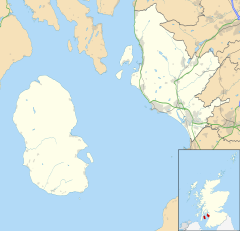Ardrossan, Scotland
Ardrossan
|
|
|---|---|
 |
|
| Ardrossan shown within North Ayrshire | |
| Population | 10,952 (2001 census) est. 10,520 (2006), excluding Saltcoats & Stevenston |
| OS grid reference | NS232424 |
| • Edinburgh | 79.1 mi |
| • London | 432.3 mi |
| Council area | |
| Lieutenancy area | |
| Country | Scotland |
| Sovereign state | United Kingdom |
| Post town | ARDROSSAN |
| Postcode district | KA22 |
| Dialling code | 01294 |
| Police | Scottish |
| Fire | Scottish |
| Ambulance | Scottish |
| EU Parliament | Scotland |
| UK Parliament | |
| Scottish Parliament | |
Ardrossan (Gaelic: Àird Rosain, "headland of the deer/oxen") is a town on the North Ayrshire coast in south-western Scotland. Although there are high levels of deprivation around the town centre of Ardrossan, the town is gentrifying but with some suburban developments around the outskirts of the town. The town has a population of roughly 11,000 and forms part of a conurbation with Saltcoats and Stevenston. Ardrossan is located on the east shore of the Firth of Clyde.
Ardrossan's roots can be traced to the construction of its castle 'Cannon Hill', thought to be in around 1140, by Simon de Morville. The castle and estate passed to the Barclay family (also known as Craig) and through successive heirs until the 14th century when it passed to the Eglinton family on the death of Godfrey Barclay de Ardrossan, who died without an heir. Sir Fergus Barclay, Baron of Ardrossan was said to be in league with the Devil and in one of his dealings, set the task for the Devil to make ropes from sand; on failing to do so, the Devil kicked the castle with his hoof in frustration and left a petrosomatoglyph hoofprint.
The castle stood until 1648, when Oliver Cromwell's troops had it destroyed, taking much of the stonework to Ayr to build the citadel at Montgomerieston. The ruins of Cromwell's Fort still stand, but are overgrown and in a dangerous condition.
In 1759 the Earl of Eglinton formed a herd of the ancient breed of White or Chillingham cattle at Ardrossan, probably using stock from the Cadzow herd. The numbers dropped and in 1820 the remaining animals were dispersed. All the animals in the herd were hornless.
...
Wikipedia

